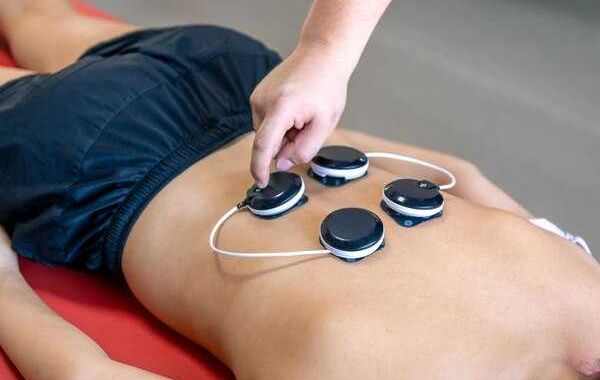Almost everybody occasionally experiences back pain that affects daily activities. It's normal, as we live complicated lives in which our physical well-being comes second. Because of your work schedule, has your health been negatively affected? Do you often lift heavy objects, and has this resulted over time in the unravelling of sciatica pain and numbness? Is your job static, and do you spend hours in front of a computer? Then, to get rid of chronic pain, an excellent idea would be to turn to shockwave therapy in Sydney.
Back pain is problematic because it is the most common health issue encountered globally and can escalate into complicated conditions that require specialist help. It can have a significant financial effect on daily activities, decrease productivity, and become chronic, necessitating complex treatment options. Do you want to prevent early complications that can affect your long-term well-being? Then, chiropractic techniques and shockwave therapy are options to consider.
Usually, back pain is caused by muscle strains, herniated discs or spondylosis of the vertebrae. However, as the years go by, the issues that lead to spinal pain could degenerate into dangerous ailments such as rheumatoid arthritis and ruptured disks. Lack of exercise, age, and improper posture are all risk factors that can lead to spinal problems. However, in almost all cases, the damage can be mitigated with the help of professional chiropractic help. Are spinal manipulation techniques and shockwave treatment enough? Not always. Nevertheless, they help, and when combined with posture correction exercises, they can be a tool to remedy the hidden causes of the pain.
What Is ESWT?
Extracorporeal Shock Wave Therapy, or ESWT, is a noninvasive medical technique that entails redirecting high-intensity acoustic waves deep inside subcutaneous tissues. It is an effective method for reducing local inflammation, can be used on back muscles and joint ligaments, and is often used in combination with other chiropractic techniques, such as spinal manipulation and Transcutaneous Electrical Nerve Therapy.
High-intensity shockwave therapy in Sydney works by redirecting acoustic waves to specific points located in subcutaneous layers of the skin. Most of the time, these high-intensity waves are generated electromagnetically and are focused on the desired tissue with the aid of a metal applicator. Shockwave treatment generates high-intensity sound waves that create micro-tears in the affected tissue, which promotes the body's natural healing properties. The process is similar to that of building muscle. Once the micro-tears are produced, they increase blood flow, aid in the release of endorphins, and act on the signals of pain receptors.
Does It Work?
Yes. Shockwave treatment is one of the most effective non-invasive treatments that can be used concomitantly with spinal manipulation. It vastly reduces inflammation in the case of spondylosis or spinal stenosis and lower-limb tendinopathy. Moreover, ESWT is a technique with minimal complications, requiring treatment sessions that do not exceed 30 minutes. Plus, it's not painful, and for many patients, it can be an alternative to surgeries and other invasive treatment options. That's not to say that ESWT can heal anything.
Although it's a safe and well-established treatment option, ESWT cannot work wonders for traumatic or degenerative conditions that need high-invasive treatment options. What ailments can be helped by shockwave treatment? Firstly, ESWT is effective in the treatment of plantar Fasciitis, which is one of the leading causes of chronic heel pain. Moreover, ESWT can be an effective treatment aid in Achilles Tendinopathy, and it's commonly used in the management of Epicondylitis. However, for other diseases, such as fractures and inflammatory arthritis, ESWT is less effective, and for the latter, it may even lead to worsening symptoms.
What Is the Difference Between ESWT and TENS?

Extracorporeal Shockwave Therapy works by redirecting high-intensity acoustic shockwaves to subcutaneous tissue. In contrast, Transcutaneous Electrical Nerve Stimulation works through low-voltage electrical impulses that are transmitted via electrodes placed on the epidermis. Both techniques are effective in treating local inflammation and are used for chronic degenerative conditions and as an adjunctive treatment for postoperative pain or injuries. Moreover, both shockwave treatment and TENS are successfully used for the treatment of idiopathic back pain, and they stimulate the release of serotonin and endorphins.
In terms of temporary side effects, ESWT can lead to slight bruising or swelling, while in TENS, the main side effect reported is skin irritation. ESWT is recommended for the treatment of plantar fasciitis and tendonitis, while TENS is mainly used for muscle strains and localised back pain. Moreover, in the case of both techniques, treatment sessions are usually relatively short, hovering around the 30-minute mark. Nevertheless, in ESWT, several sessions may be required.
Are you based in Sydney and need effective treatment for back pain caused by muscle strains and spinal misalignments? If so, both ESWT and TENS may be treatments to consider. Plus, as they are non-invasive, they can be combined with other types of treatments, such as spinal manipulation or soft tissue massages, which, together with a muscle strengthening plan, will almost certainly improve your situation.
It’s a Safe Bet
Are you looking for an efficient shockwave treatment, and are you located in Sydney? In that case, you're in luck, as most likely, you'll have a chiropractic clinic in your local area. Why should you utilise the services of chiropractors? It's all about expertise. Although in many countries, chiropractic is controversial due to the flexibility of regulations, things are different in Australia.
In our country, chiropractors must complete at least three years of college education and graduate with a Bachelor of Chiropractic or a similar degree. They then need to follow this up with a two-year master's degree in chiropractic science. Furthermore, aspiring chiropractors must register with the AHPRA, engage in continuous professional development, and be insured for the services provided.
In short, in Australia, chiropractic is a recognised health profession that has been regulated since the 1970s. Is it safe? Yes, as spinal manipulations are only performed by experienced practitioners who know what they're doing. When combined with ESWT, TENS, or deep tissue massages, chiropractic techniques like spinal manipulation are effective in treating localised pain, can restore muscle mobility, can reduce the pressure on surrounding nerves and act as a building block of a comprehensive long-term treatment plan.







